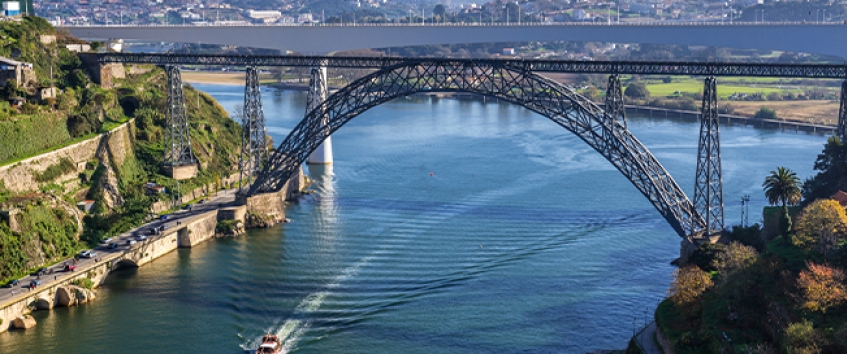Without a doubt, the Douro Bridges Cruise is one of the most popular tourist packages in Porto. We can state without any hesitation that there is no tourist in Porto who does not take this beautiful cruise.
In fact, many claim that it is from the river that one has the most beautiful view of the city. We cannot say for sure if it is really the most beautiful view but a trip along the banks of Porto and Vila Nova de Gaia is a unique experience that you will not want to miss!
On this beautiful boat trip, you will be dazzled by the six magnificent bridges that cross the Douro River. With peculiar stories and facts, they are beautiful and world famous. Get to know, thus, the wonderful structures that connect (or have connected) the two banks of the Douro River!
A little bit of the History of Bridges over the Douro River
In the past, the crossing between the banks of Oporto and Vila Nova de Gaia was made using boats, rafts or barges. However, the need was felt for a permanent crossing between the two banks of the Douro for the movement of people and goods. Thus, Barcas Bridge was born in 1806. This bridge was made up of 20 barges connected by steel cables and could be opened to allow river traffic to pass.
However, the traffic increased rapidly and a new bridge had to be built. Thus, in 1843, the famous Pênsil Bridge was built. This suspension bridge was only decommissioned after the opening of the D. Luís I Bridge in 1886, situated right next to it, which is today the oldest bridge in the city of Porto that is still active.
D. Luís I Bridge (or D. Luiz I, after its real name) is Porto's most iconic bridge and one of the most famous in Portugal. With a metallic structure and two decks, it was built between 1881 and 1888 (year in which the second deck was completed) and designed by Teófilo Seyrig, one of Gustave Eiffel's disciples. The iron arch of this bridge is considered to be the largest wrought iron arch in the world.
But when we cross the Douro River aboard a fantastic cruise ship, we notice that the D. Luís Bridge is not the oldest bridge in the city. The Maria Pia Bridge, built between 1876 and 1877 by Gustave Eiffel's company, was the first railway bridge to connect the two banks of the Douro. Equipped with a single track - which meant that only one train had to pass at a time, at a speed not exceeding 20km/h and with very limited loads - in the last quarter of the 20th century it became clear that this bridge no longer responded satisfactorily to the needs. The magnificence of this bridge can still be seen, but it is now out of service.
To provide a more effective answer to the railway connections, São João Bridge was then built. Designed by Edgar Cardoso, its construction began in 1984 and it was only opened in 1991, after successive advances in completion and a financial slippage justified by its high technical complexity. Unlike most bridges, this one is not arched, but rather a continuous multiple portico with vertical columns and three spans. Although, at the time, some experts considered its inauguration a little premature, this railway infrastructure continues to carry the North Line over the River Douro.
Besides the São João Bridge (railway) and the D. Luís I Bridge (road and Porto Metro), three other active bridges currently connect the two banks of the Douro. The Arrábida Bridge was inaugurated in 1963 and was designed by Edgar Cardoso. At the time of its construction, it had the longest reinforced concrete arch in the world. With a span of 270m, it reaches 70m above mean water level. Despite the later construction of Ponte do Freixo, Ponte da Arrábida remains the main link between the city of Porto and the south bank of the Douro.
Of the bridges connecting Porto to Vila Nova de Gaia, the Freixo Bridge is the one that is furthest upriver. It was built in an attempt to minimise traffic congestion experienced on the Arrábida and D. Luís I Bridges, particularly noticeable since the late 1980s. Designed by Professor António Reis, it was inaugurated in 1995, and has some interesting features: it is, in fact, two bridges built side by side, 10 cm away from each other. It currently has eight lanes and is intended exclusively for road traffic.
Finally, the Infante Bridge is the most recent bridge to connect the two banks of the Douro River. Named in honour of Infante D. Henrique, it was built to replace the upper deck of the D. Luís I Bridge, which has since been converted for use by the Porto Metro. Built in the heart of the historical centre, it connects the picturesque Bairro das Fontaínhas to the famous Serra do Pilar (where you can enjoy one of the most beautiful views over Porto). Inaugurated in 2003 and designed by Adão da Fonseca, this high level bridge is considered by many specialists worldwide as one of the most slender bridges of its kind.
The best way to discover the Douro River
Now that you know the six Bridges of the Douro River, pay them a visit. On our Douro Bridges Cruise, you will cross 5 incredible bridges (Arrábida, D. Luís I, Maria Pia, São João, Infante) and observe the Freixo Bridge (since the riverbed narrows in this area, it would not be possible for boats to cross the bridge and return in 50 minutes).
This trip is made in Rabelo Boat, to get the most of a typical experience. In addition, you will be accompanied by our Guide, to learn more information about the bridges, the banks and the iconic monuments that can be glimpsed from the Douro River.
Enjoy the beauty of the Invicta city on board our cruises!

